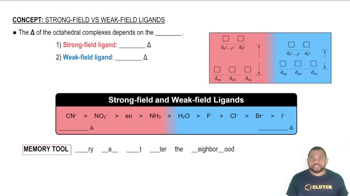Here are the essential concepts you must grasp in order to answer the question correctly.
Cathode Rays
Cathode rays are streams of electrons observed in vacuum tubes. They are produced when electrons are emitted from a cathode and travel towards an anode. The behavior of cathode rays, including their deflection, is crucial for understanding the nature of electric charge and the structure of atoms, as demonstrated in Thomson's experiment.
Recommended video:
Characteristics of Gamma Rays
Electric and Magnetic Fields
The deflection of cathode rays in Thomson's experiment is influenced by external electric and magnetic fields. When these fields are applied, they exert forces on the charged particles (electrons), causing them to change direction. The strength and orientation of these fields directly affect the degree of deflection observed.
Recommended video:
Strong-Field Ligands result in a large Δ and Weak-Field Ligands result in a small Δ.
Charge-to-Mass Ratio
The charge-to-mass ratio of the electrons is a critical factor in determining how much they will deflect in an electric or magnetic field. A higher charge-to-mass ratio results in greater deflection for a given field strength. Thomson's experiment aimed to measure this ratio, providing insights into the properties of electrons and their role in atomic structure.
Recommended video:





